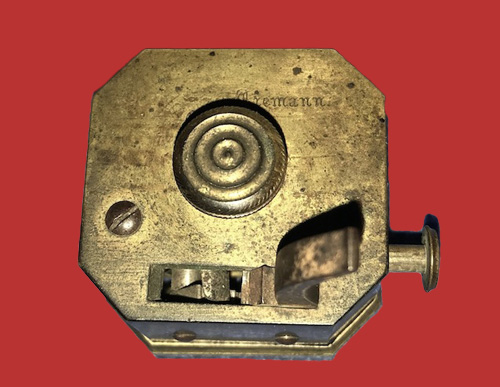
This scarificator made by Tiemann has 12 blades, and has a hexagonal design. The blades can be “half-cocked” by use of the curved thumb lever, and then rapidly released to their full depth by depressing the button on the side. “Tiemann” is stamped on the top in Old English font, which is consistent with the time period noted. This is in perfect working condition.
THE PRACTICE OF BLOODLETTING
(IN A NUTSHELL)
Hippocrates theory of illness and disease held that there were four main bodily humors: blood, phlegm, black bile, and yellow bile, and that health was associated with a balance in all four humors. Disease was the result of the “corruption” of one or more of the humors, which could be caused by environmental circumstances, dietary changes, or many other factors. An imbalance in these humors was postulated as the need for bloodletting, purging, vomiting, etc. Virtually every known medical condition at one time or another was treated by these methods. Bloodletting was used to treat everything from fever and madness to anemia and debility. As one can imagine, treating an anemic patient by removing even more blood was not the best of ideas. The popular belief that George Washington was bled to death proves that even “nobility” was not spared.
By the 19th century, the scarificator was an essential tool in the practice of bloodletting. First developed in the early 1700s as a more humane and efficient bloodletting instrument than lancets and fleams, scarificators had multiple blades that shot out with the press of a spring-loaded lever creating an instantaneous series of parallel cuts in the skin of the patient. Scarificators could be square or round in shape, but by 1790, octagonal boxes such as this one were favored in Britain and North America. America.
Once the scarificator sliced the patient, a cup was often placed over the wound as a receptacle for the blood. Cups were made of tin, brass, rubber, horn, and most commonly glass. However, there is evidence they were also sometimes used by physicians for other purposes – long after the use of scarificators for bloodletting had gone out of fashion in Western medicine, Dr. Howard Box and Dr. G.S. Cronk employed this instrument for smallpox vaccinations in China in 1918.
